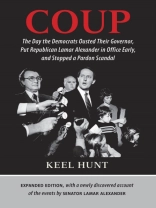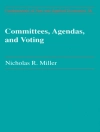Coup is the behind-the-scenes story of an abrupt political transition, unprecedented in US history. Based on 163 interviews, Hunt describes how collaborators came together from opposite sides of the political aisle and, in an extraordinary few hours, reached agreement that the corruption and madness of the sitting Governor of Tennessee, Ray Blanton, must be stopped. The sudden transfer of power that caught Blanton unawares was deemed necessary because of what one FBI agent called ‘the state’s most heinous political crime in half a century’—a scheme of selling pardons for cash.
On January 17, 1979, driven by new information that some of the worst criminals in the state’s penitentiaries were about to be released (and fears that James Earl Ray might be one of them), a small bipartisan group chose to take charge. Senior Democratic leaders, friends of the sitting governor, together with the Republican governor-elect Lamar Alexander (now US Senator from Tennessee), agreed to oust Blanton from office before another night fell. It was a maneuver unique in American political history.
Expanded edition, with a newly discovered account of the events by Senator Lamar Alexander:
‘In December 2015 something unexpected happened. Keel [Hunt] delivered to my Nashville office a brown three-ring binder. He had only recently discovered it in a box that had been in storage for thirty years.’ —Senator Lamar Alexander
This binder contained the forgotten typescript, written in 1985, of Alexander’s recollections of the events leading up to his early inauguration on January 17, 1979. In this expanded edition of
Coup, the Senator’s 22, 000-word text has been added as a lost footnote to Hunt’s definitive account.
From the foreword by John L. Seigenthaler:
‘The individual stories of those government officials involved in the coup—each account unique, but all of them intersecting—were scattered like disconnected pieces of a jigsaw puzzle on the table of history until the author conceived this book. Perhaps because it happened so quickly, and without major disagreement, protest, or dissent, this truly historic moment has been buried in the public mind. In unearthing the drama in gripping detail, Keel Hunt assures that the ‘dark day’ will be remembered as a bright one in which conflicted politicians came together in the public interest.’
สารบัญ
Author’s Preface to the Expanded Edition
Foreword |
by John L. Seigenthaler
Chapter 1: The Stranger
Chapter 2: The Sharecropper’s Son and Nixon’s Choirboy
Chapter 3: The Red-and-Black Plaid Shirt
Chapter 4: The Murders
Chapter 5: The Madness
Chapter 6: A Man of Great Promise
Chapter 7: The Dominion of the Editor-in-Chief
Chapter 8: The Attorney General and the Rule of Law
Illustration Gallery 1
Chapter 9: The New List and the Ticking Clock
Chapter 10: The Turmoil
Chapter 11: The Call
Chapter 12: The Rise of the Speaker
Chapter 13: The Cosmos of the Lieutenant Governor
Chapter 14: The Dance
Chapter 15: The Decision
Illustration Gallery 2
Chapter 16: The Yellow-Dog Chief Justice
Chapter 17: The Arrival
Chapter 18: The Oath
Chapter 19: The Scramble
Chapter 20: The Long Night
Chapter 21: The White Morning
Epilogue: What Became of Them
Timeline
Postscript: A Note on Sources
The Interviews
Bibliography
Acknowledgments
Lost Manuscript Found: My View of the Coup from the Eye of the Storm |
by Lamar Alexander
Index
เกี่ยวกับผู้แต่ง
Keel Hunt is a columnist for the USA Today Network in Tennessee. He has been a reporter, editor, Washington correspondent, and editorial writer. From 1979 to 1986 he was Special Assistant to Governor Lamar Alexander.












